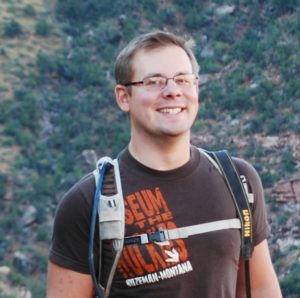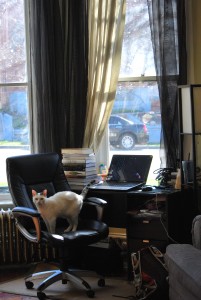
What I’m working on:
I swing back and forth between panicking over not having enough work and taking on too much. At the moment, I’m trying to find the joy in being swamped.
Writing my blog Laelaps for National Geographic is my primary gig. Everything else is freelance work, which consists of looking for new assignments while trying to tackle the ones I’ve already taken on. This week, that has meant filing stories on giant swimming sloths and a 28-million-year-old whale skull while finding time to run downtown for radio interviews on de-extinction and a giant Jurassic carnivore. I need to take some old stories about conservation paleobiology, the world’s small cats, and dinosaur size off the back burner, as well, not to mention pitching new stories.
But books are what I love best. I’ve spent about almost a year and a half trying to pin down my next major book—which is going to be about the natural and unnatural history of our skeletons—and I just started up a personal project that melds paleo fiction with art and science. While I try to get those books off the ground, I’m also writing an entire special issue of National Geographic devoted to the time “when dinosaurs ruled.” The short-term projects keep the lights on persistently enough that I can approach the bigger projects I want to pursue.
Where I work:

I work from a desk pushed up against the front window of my Salt Lake City apartment. It’s not my ideal setup—I prefer to be closely surrounded by bookshelves in a place where I can push everything else out of my mind—but the view of the Wasatch Front from here is still a nice perk. Not that I’m always home to work. I’ve tuned-up and filed stories from desert trails, fossil prep labs, and parking lots when urgent edits have come through on short notice.
Daily routine:
Most mornings my alarm goes off at an optimistically early hour and, sometimes not even awake, I hit the snooze button for a few more minutes. But Nighttime Brian knows two things that Morning Brian forgets: that there are additional alarms, and that the cats will descend upon him at the slightest hint that he’s awake.
With anywhere from one to five cats impatiently standing on my chest and putting their carnassials to work on the edges of my iPhone, I groggily check Twitter and my email to see what’s new and if there are any updates about work. Living in the Mountain Time Zone means that I’m hours behind most of my editors and writing acquaintances, so what’s in my inbox often determines how quickly I drag my carcass out of bed
As soon as my feet hit the floor, there is no stopping the kitty chaos. Feeding them and replacing ornery yowls with the sound of crunching kibble is always my first task. I brush my teeth, shower, and pour a glass of orange juice to start my engine. Then I decide what to do with the day.
Autumn and winter days are the most difficult. The bedroom grows so cold that getting out of bed requires a feat of motivational strength. But once I’m shocked awake by The Chill, I usually get to work by 9 a.m. and barely budge from my desk until noon.
Morning is the time to plow through as many deadlines, interviews, emails, and other essential tasks as possible. The midafternoon is usually when I break for lunch, take care of chores, run errands, feed the cats, and otherwise try to stave off cabin fever. I’ve never gotten the hang of midafternoons, anyway, and I’m of the belief that anything I write between 1 p.m. and 4 p.m. is going to be absolute drivel. The evenings are a little more broken up, but I usually work on bigger, longer-term projects between dinner and the time my wife and I spend winding down from the day’s work.
Spring and summer days are far more pleasant. I want to absorb as much of the warmth and light as I can, and on the days when I’m home I get out of bed by 7:30 a.m., quickly take care of the cats, and go for an hour-long walk around the local park. When I get home, I take a book and a cup of tea out to the front porch and read for another hour or so. The book could be something directly related to my writing or something for pleasure. It doesn’t really matter so long as I feed my brain as the sun comes up over the mountains. I feel much sharper when I’ve taken care of myself. Once I’ve started, I generally follow my same pattern of essential tasks, midafternoon lull, and evening writing.
That last paragraph may have sounded bucolic, but it only describes an optimal morning. I am a freelancer, after all. I don’t get my preferred schedule all the time. If edits come in early for a news story, then I drop everything else and get to them. The same goes for evenings. Now and then I get article pitches or interview requests after 8 p.m. that are due the next morning. Work has no respect for sleep.
But no matter what else I do, there is one essential moment of every workday that never changes. No matter what time it is or what I’m doing, whenever my wife, Tracey, gets home from work I get up from my desk, open the front door, give her a hug, and ask her how her day was. Those moments remind me why I write and how she has always supported my awkward transition into becoming a professional writer.
Most productive part of my day:
I am not a morning person at all, but the stretch between wake-up and lunch is when I most effectively drill into the strata of my work pile. That’s when anxiety, guilt, inspiration, and motivation are strongest for me. Morning is the time when I do the work I have to do, and evening is when I write what I want to.
Most essential ritual or habit:
Taking time out to read. I don’t do this regularly enough to call it a ritual or habit, but whenever I remember to feed my brain I feel infinitely happier than if I’m hazily punching words onto the page.
Mobile device:
An iPhone5c. I resisted smartphones for a long time, mostly because I got along fine with my phone being my phone and my computer being my computer, but now my iPhone is the most vital piece of equipment I have. The phone lets me respond to emails and edits on the fly, snap photos of fieldwork, record audio for impromptu interviews, and track down stories through social media. I write on my laptop, but I do most of my actual work with my smartphone.
Computer:
In 2010, I blew the small honorarium I got to write Written in Stone on a Dell PC laptop. That computer has been my workhorse ever since, and has been forgiving enough not to self-destruct after the few times I’ve carried it out to desert field sites with me. It’s a bit of a monster to lug around when I travel, but at least that gives it the additional benefit of giving me a regular workout.
Essential software/apps/productivity tools:
Twitter. I know the app is often thought of a time-waster, but the constant flow of news is where I often find out about stories, fortuitously bump into experts that I later call for comments, and have conversations that generate posts and stories. It’s so easy to be myopically focused on my own world, and dipping into the Twitter stream offers a refreshing flow of ideas, opinions, and curiosities.
Favorite time waster:
I don’t waste time. That doesn’t mean that I’m always writing or chasing down leads.
I regularly take time out to sift through social media, read, go on hikes, and noodle around on guitar whenever I feel I need to (as long as there’s not a deadline loomed directly overhead). Aside from giving me a breather from the task at hand—more times than not, the solution to stubborn intros or conclusions come to me while I’m away from my desk—my down time gives me new cultural touchstones, ways to think about storytelling, and tidbits of inspiration. I’m not going to argue that spending hours learning how to play the Foo Fighters’”Everlong” on RockSmith has directly improved my writing, but I can’t function as a perpetual, self-sustaining wordsmith. I need input and to give my mental gears regular rest. I like to think of even the most frivolous activity as time well-spent as long as I get up to write tomorrow.
My reading habits:
Most of what I read is dictated by what I write. And since I make a living writing about bizarre creatures from the past 550 million years, most of what I read are books and articles that enthuse over Darwin’s “endless forms most beautiful and most wonderful.” Stephen Jay Gould and David Quammen are authors I return to over and over, although it’s always a joy when writers such as Mary Roach and Deborah Blum lead me out of my comfort zone into areas of science I’m not as familiar with. I read the posts and articles of friends and colleagues as I come across them, but there’s really nothing like cracking open a finely-crafted book and totally getting lost.
I’ve also put myself on a fiction regimen. I still love non-fiction most of all, but lately I’ve been totally absorbed by books such as Jonathan Tropper’s How to Talk to a Widower, David Wong’s This Book is Full of Spiders, and Mike Mignola’s early Hellboy volumes. I can hardly wait for Terry Pratchett’s Raising Steam, and I just started reading J.K. Rowling’s Harry Potter series (which I waited far too long to do). Especially since so many creatures I write about only exist where science and speculation meet, I need to nourish my imagination as much as the scientific side of my brain.


